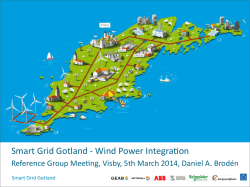
B2.62 - Dansk Energi
CIGRE Study Committee B2 PROPOSAL FOR THE CREATION OF A NEW WORKING GROUP WG* N° B2.62 Name of Convenor : Javier Iglesias (Spain) E-mail address: jiglesias@ree.es Technical Issues # 3, 5, 9 Strategic Directions # 1, 3 The WG applies to distribution networks: No Title of the Group: Design of Compact HVDC Overhead Lines Scope, deliverables and proposed time schedule of the Group : Background : As the need for HVDC links within or overlaying existing AC systems is more widely recognized, rights-ofway for those lines become increasingly difficult to obtain. It is therefore appropriate that CIGRE undertake studies leading to greater compaction of DC lines in order to reduce their visual and environmental impact (making regulatory approval easier) and to allow their construction on narrower rights of way – possibly shared with public transport routes. Recognizing that the electrical, mechanical and environmental constraints associated with compact HVDC transmission lines differ from those associated with HVAC lines, the key issues to be addressed are listed in the following scope. Scope : Needs of Target Groups : 1. 2. 3. Increase power flow capacity on HVDC line with restricted right-of-way. Design compact HVDC lines with live maintenance in mind. High power transfer capacity requires high levels of reliability. Terms of reference: The main tasks of the WG are: 1. Shortening spans has a leveraged benefit in tower height, conductor out-swing, wind and weight loading of structures and of footing requirements. Comparative studies will be undertaken to develop general guidelines demonstrating the tradeoff of those structural cost savings and the cost of more structures per kilometer. 2. Shorter spans and reduced loading allow introduction of alternative tower structures. A review of those alternatives as adapted to DC will be undertaken with emphasis on the civil and mechanical aspects, with examples to help identify approaches advantageous to HVDC compaction. 3. Insulation options for achieving maximum compaction, such as V string insulators and insulated cross-arms, will be documented and evaluated. 4. Compacting HVDC lines will require a more accurate assessment of acceptable field and corona and ground field effects, recognizing that: a. b. c. 5. Calculated results typically differ between popularly used software field and corona effects packages Popularly cited limits for ground-level fields and ion current density usually are exceeded on existing HVDC lines without a record of complaints, and Very wide variations in levels with time suggest an improved approach to assess annoyance. Limiting the electric field level and ion current density at ground level becomes increasingly difficult as minimum conductor height is reduced to levels consistent with human safety. Closer pole spacing reduces those effects at the cost of higher conductor gradient or conductor sizes in excess of those needed for thermal rating. Alternative means of limiting field effects will be investigated, including Page 1 / 3 but not limited to, underbuilt ground wires. 6. Minimum right-of-way widths should be determined to allow the siting of compact HVDC transmission on road-sides or rail-sides, or shared with existing rights-of-way. These sitings present an attractive alternative to the development of new rights-of-way across open terrain. An assessment of this prospect will be undertaken to explore: a. b. c. The availability of new rights-of-way suitable for compact HVDC transmission The special construction challenges such routes present, e.g. intersections, overhead bridges, commercial development, etc. The special risk and safety considerations associated with rights of way for compact HVDC transmission lines. Specific Actions are: 1. Prepare a Technical Brochure or Electra scientific paper 2. Prepare a tutorial, including possibly a demo ► Target date – 2018 Deliverables : Report to be published in Electra Time Schedule : Start : June 2015 Final report : December 2018 Comments from Chairmen of SCs concerned : Approval by Technical Committee Chairman : Date : 24/04/2015 Page 2 / 3 Table 1: Technical Issues of the TC project “Network of the Future” (cf. Electra 256 June 2011) 1 Active Distribution Networks resulting in bidirectional flows within distribution level and to the upstream network. 2 The application of advanced metering and resulting massive need for exchange of information. 3 4 The growth in the application of HVDC and power electronics at all voltage levels and its impact on power quality, system control, and system security, and standardisation. The need for the development and massive installation of energy storage systems, and the impact this can have on the power system development and operation. 5 New concepts for system operation and control to take account of active customer interactions and different generation types. 6 New concepts for protection to respond to the developing grid and different characteristics of generation. 7 New concepts in planning to take into account increasing environmental constraints, and new technology solutions for active and reactive power flow control. 8 New tools for system technical performance assessment, because of new Customer, Generator and Network characteristics. 9 10 Increase of right of way capacity and use of overhead, underground and subsea infrastructure, and its consequence on the technical performance and reliability of the network. An increasing need for keeping Stakeholders aware of the technical and commercial consequences and keeping them engaged during the development of the network of the future. Table 2: Strategic directions of the TC (cf. Electra 249 April 2010) 1 The electrical power system of the future 2 Making the best use of the existing system 3 Focus on the environment and sustainability 4 Preparation of material readable for non technical audience Page 3 / 3
© Copyright 2025















